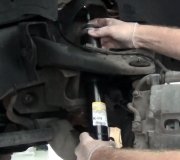Hi,
Yep, very familiar. That saves you needing a longer spring and shock.
When you describe it as bouncy, and this is going to make me sound like a fool, but do you mean it wants to continue bouncing up and down (like a blown shock)? Or are you experiencing a stability issue?
I suspect the tire size has been changed as well. Are they properly inflated?
Here are the directions for checking the shocks right from Alldata. Let me know if it helps.
_________________________________
1998 Ford Truck Expedition 2WD V8-5.4L SOHC VIN L
Shock Absorber
Vehicle Steering and Suspension Suspension Suspension Strut / Shock Absorber Testing and Inspection Initial Inspection and Diagnostic Overview Shock Absorber
SHOCK ABSORBER
CAUTION: The low pressure gas shock absorbers are charged with nitrogen gas to 931 kPa (135 psi) for 1-3/16 inch bore, and 1034 kPa (150 psi) for 1-3/8 inch bore. Do not attempt to open, puncture, or apply heat to the shock absorbers.
All vehicles are equipped with low pressure gas-filled hydraulic shock absorbers of the direct acting type. They are non-adjustable and non-refillable. They cannot be serviced as cartridges and must be serviced as shock assemblies.
Before replacing a shock absorber, check the action of the shock absorbers as follows.
1. Check all tires for proper inflation pressure.
2. Check tire condition to confirm proper front end alignment, tire balance and overall tire condition such as separation or bulges.
3. Check the vehicle for optional suspension equipment such as heavy-duty handling or trailer tow suspensions. These suspensions will have a firmer feeling ride than standard suspensions.
4. Check the vehicle attitude for evidence of possible overload or sagging.
Many times, front springs and front shock absorbers are replaced in an effort to solve a vehicle sag concern. Shock absorbers are, by design, hydraulic damping units only and unlike suspension springs, do not support any suspension loads. Therefore, replacing a shock absorber will not correct a vehicle sag concern.
5. Road test the vehicle to confirm the customer concern.
6. Make sure the shock absorber is securely and properly installed.
7. Check the shock absorber insulators for damage and wear.
Replace any worn or damaged insulators and tighten attachments to the specified torque (on a shock absorber which incorporates internal insulators, replace the shock absorbers).
10. Inspect the shock absorber for evidence of fluid leakage. Leakage is a condition in which the entire shock body is covered with oil, and the oil will drip from the shock onto the pavement.
A light film of oil (weepage) on the upper portion of the front shock absorber is permissible and is a result of proper shock lubrication. Weepage is a condition in which a thin film of oil may be deposited on the shock outer tube (body) and is normally noticed due to the collection of dust in this area. Front shock absorbers which exhibit this weepage condition are functional units and should not be replaced.
11. If leakage exists:
- Make sure the fluid observed is not from sources other than the front shock absorber.
- Replace the worn or damaged front shock absorber.
12. Disconnect the lower end of the shock absorber.
13. Extend and compress the shock absorber as fast as possible, using as much travel as possible. Action should become smooth and uniform throughout each stroke.
- Higher resistance on extension than on compression is a normal condition.
- Faint swish noises are also normal.
_________________________________
Keep in mind, the vehicle is handling differently now because of the lift. Also, if you have put bigger tires on it, that may also be a cause or at least making a weak shock more noticeable.
Let me know.
Joe
Saturday, March 7th, 2020 AT 8:21 PM



